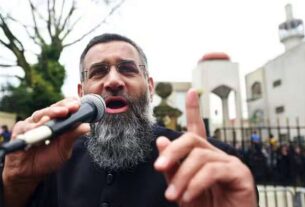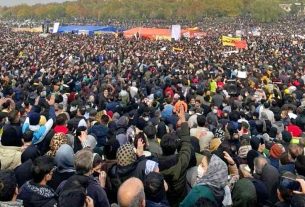Wed 21 February 2024:
In March and August 2018, up to a year before he attacked two Christchurch mosques, Brenton Tarrant posted publicly online that he planned to do so. Until now, these statements have not been identified.
In fact, for four years before his attack, Tarrant had been posting anonymously but publicly on the online message board 4chan about the need to attack people of colour in locations of “significance”, including places of worship.
In its final report in 2020, the royal commission of inquiry into the terror attacks wrote:
The individual claimed that he was not a frequent commenter on extreme right-wing sites and that YouTube was, for him, a far more significant source of information and inspiration. Although he did frequent extreme right-wing discussion boards such as those on 4chan and 8chan, the evidence we have seen is indicative of more substantial use of YouTube and is therefore consistent with what he told us.
Given the importance of online environments in radicalising lone actor terrorists, we questioned this and set out to investigate whether right-wing websites were important in Tarrant’s radicalisation.
What we found overturns a great deal of what we thought we knew about him. It also raises serious questions, not only about why this posting was not detected before the attack, but also why it has not been discovered in the five years since the March 15 attacks.
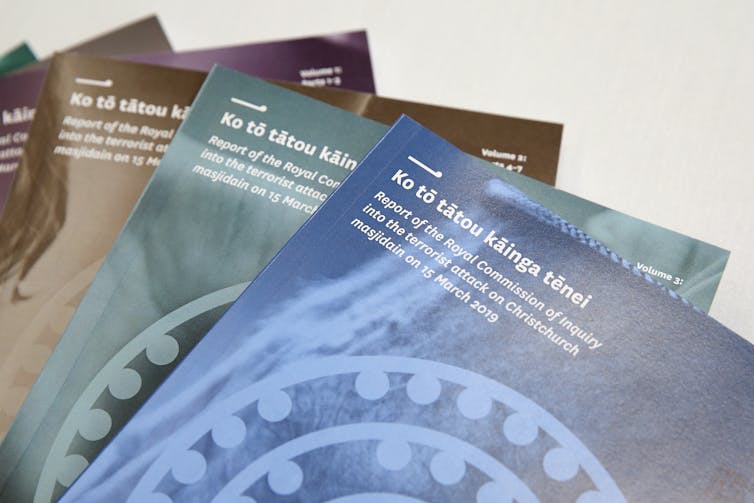
Did the royal commission of inquiry report into the Christchurch terror attacks have the information it needed? Getty Images
Beyond the manifesto
Having the opportunity to see Tarrant interact candidly with his online community, we see that much of what he stated in his manifesto was propaganda.
When he wrote in his manifesto that he was driven to violence by the lack of a political solution – a realisation that came to him in 2017 – we now know he had been calling for attacks against civilians at least as early as 2015.
Where he claimed he was not driven by antisemitism, we found hatred and conspiratorial distrust of Jews were central to his entire worldview.
Although he claimed in his manifesto that he carried out his attack to preserve diversity and respect for all cultures, the violent racism and Islamophobia in his posting sets him apart, even in the darkest corners of 4chan.
We will be publishing more about Tarrant’s online history, including what radicalised him and what lessons can be learned. Here we introduce some of our initial findings.
Among other revelations, we show that there were numerous opportunities for the public and New Zealand and Australian security services to observe him making very threatening statements online.
We’ve chosen to repeat only a small number of Tarrant’s statements, given their highly offensive nature. However, we still advise caution before reading further.
How we found the posts
Because 4chan posts are anonymous, we used a combination of indicators to identify Tarrant. 4chan’s “politically incorrect” board – referred to as /pol/ – provides the time, date and location of each post, allowing us to match this against Tarrant’s travel to numerous countries over five years.
Tarrant also frequently provided personal information in his posts, and he used the same distinctive language. In some cases, he repeated points we know he made elsewhere. He openly and proudly stated his Australian identity, even as he called for violence.
He also often made specific grammatical errors which make his posting stand out. He uses this style in online writing samples as early as 2011, in his 2019 manifesto, and in a great deal of online posting in between. In combination, these indicators identify Tarrant.
Our team of four researchers reviewed thousands of anonymous posts and hundreds of threads on /pol/. We used the platform’s search function for particular words, phrases and images. As a team we carefully evaluated all posts which included several of the above indicators.
We maintained a very high evidence threshold for including posts in our analysis. We excluded some important statements that were almost certainly written by him, but for which only one or two of the above indicators were present.
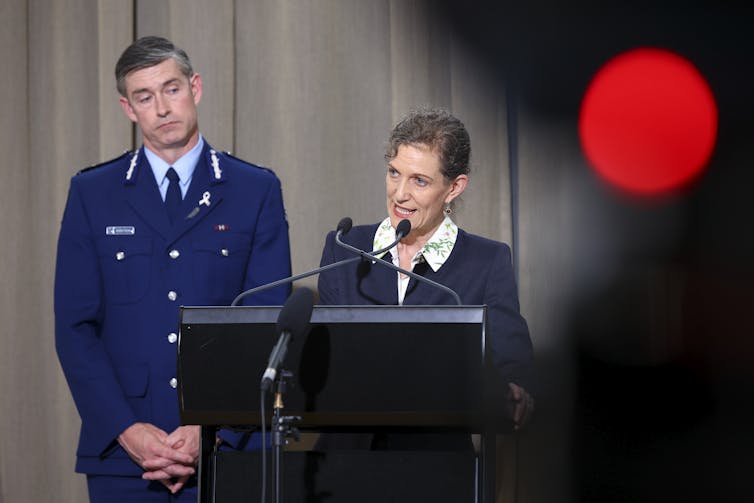
Then director-general of security Rebecca Kitteridge and police commissioner Andrew Coster speak to media at the release of the royal commission report in 2020. Getty Images
What we found
By 2015, Tarrant was calling for mass violence against people of colour. Inspired by Dylann Roof’s massacre of nine Black worshippers in a church in Charleston, South Carolina, Tarrant excitedly claimed “violence is the last resort of a cornered animal”, and “it was always going to come to this”.
It was here Tarrant made clear that white nationalist extremists should target innocent victims in locations of “significance”, such as places of worship.
When other posters claimed Roof should have targeted a “ghetto”, Tarrant became frustrated. He explained that attacking unarmed people in a church is a “very simple tactic” necessary to provoke people of colour into retaliating. He used a highly racist phrase common on the /pol/ board to refer to this strategy.
For at least four years, then, Tarrant contemplated and planned on killing people in a location of emotional importance such as a school or place of worship.
In fact, he glorified a wide range of violence, including school and public shootings, the perpetrators of which were driven by psychological or other motives rather than white nationalist ideology.
He advocated for and praised the sadistic and brutal killing of innocent civilians. The key for Tarrant was that this violence was perpetrated by white men. For him, any white violence might trigger the race war and segregation he desired.
As he travelled the world between 2014 and 2018, Tarrant became increasingly focused on Muslims. His hatred persisted after arriving in New Zealand. Sometimes it spiralled into unhinged tirades.
In one thread, he claimed he would form and fund an armed band of 4chan users to conduct ethnic cleansing in the Balkans. Some of his posting is unusually violent even within the extremism of /pol/. With hindsight at least, it suggests potential opportunities for detection, most obviously by Australian authorities.
For example, in that same thread, he identified himself as Australian four times, and brazenly wrote there was nothing the Australian government could do to stop him.
At the moment of this violent fantasy, he emailed a gun club in Dunedin stating his plans to move to New Zealand. In the same week, he made donations to international far-right leaders.
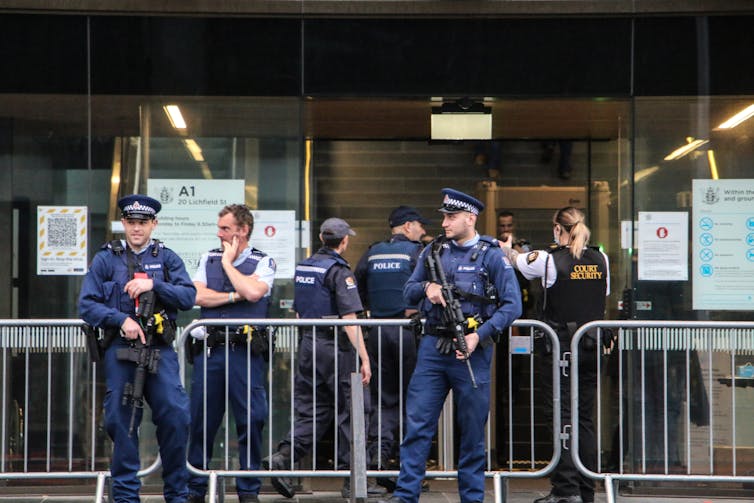
Police guard the Christchurch High Court at the sentencing of the Christchurch terrorist, 2020. Getty Images
Operational Security?
The royal commission into the Christchurch terror attacks concluded Tarrant made only “limited lapses” in operational security during his time in New Zealand between late 2017 and March 2019.
This is not the case. He posted regularly on /pol/, which is freely and publicly accessible. His posting was visible to numerous others whose identities he could not possibly know.
Two threads in March and August of 2018 in particular show his hatred of and plans to attack the Muslim community. As such, they presented opportunities for his detection.
In these threads, Tarrant and other users posted angrily about the spread of immigrants in New Zealand, and particularly the presence of mosques in small towns. Very soon, a group of anonymous posters, including Tarrant, discussed violence against the buildings (and the communities that gather in them).
When another user posted an image of a box of matches in reference to the mosques, Tarrant wrote “Soon”.
Revealing he was in Dunedin, Tarrant expressed his anger at the presence of mosques in that city, and in Christchurch and Ashburton to the north, using highly abusive language. When other users called on him to act, he wrote: “I have a plan to stop it. Just hold on.”
Far from maintaining tight operational security as he planned his attack, Tarrant openly (albeit anonymously) discussed violence against mosques in the South Island while in New Zealand.
Preventing it happening again
The 4chan community was crucial in Tarrant’s radicalisation (and the examples given here are just a portion of what we have found).
Given what we know about the importance of online environments in the radicalisation of other white nationalist terrorists, it is disturbing this aspect of Tarrant’s path to March 15 has not been investigated more thoroughly.
After all, his final words before the attack were released on the imageboard 8chan, but also intended for 4chan: “It’s been a long ride […] you are all top blokes and the best bunch of cobbers a man could ask for”.
It is hard to imagine a clearer signpost that the real nature of his radicalisation could be found on those forums.
Five years later, it seems we are only beginning to understand why he committed the atrocity, what might have been done to stop it, and how government agencies can work together with specialist extremism researchers to prevent it happening again.
This article original published in The Conversation click here
______________________________________________________________
FOLLOW INDEPENDENT PRESS:
WhatsApp CHANNEL
https://whatsapp.com/channel/0029VaAtNxX8fewmiFmN7N22
![]()
TWITTER (CLICK HERE)
https://twitter.com/IpIndependent
FACEBOOK (CLICK HERE)
https://web.facebook.com/ipindependent
YOUTUBE (CLICK HERE)
https://www.youtube.com/@ipindependent
![]()
Think your friends would be interested? Share this story!



